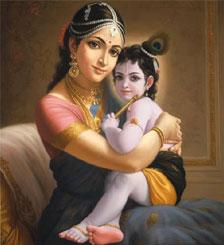
|
The Srimad Bhagavatam is one of greatest books of Bhakti in our tradition. Immensely popular all over India, it has inspired poets, saints and artists, as it provides a great range of material for their art. - Swami Ranganathananda |
Introduction
‘Bhagavatam’ means that which deals with Bhagavan, the Blessed Supreme Being. It also means the revelations of the Lord Himself (bhagavatah idam). It can mean the glory of the Lord’s devotees, bhagavatas also. Just as the syllable Omkar is said to be the sound-form of the Lord, the Bhagavatam is said to be the word-form of the Lord. Hence to know the Bhagavatam is to know the essential nature of the Lord.
The Bhagavatam is believed to have been told by Lord Narayana Himself to Brahma, the creator. This lamp of knowledge is said to have been passed on by Brahma to his son Narada, by Narada to sage Veda Vyasa, by Veda Vyasa to his son Sukadeva and by Sukadeva to King Parikshit who was under the curse of imminent death.
Bhagavatam belongs to that class of Hindu religious literature which is known as the Puranas. The Bhagavata Purana is a scripture superbly written with aesthetic sensitivity, devotional intensity, and metaphysical subtlety wherein Krishna, the warrior-charioteer-friend-philosopher-guide of the Bhagavad Gita becomes the pet child of Yashoda, the Divine Lover of the cowherd maidens and a supreme teacher to Uddhava.
The word ‘Purana’ literally means ‘narratives of ancient times’. Though the Puranic literature began to take its present shape only from the 5th century B.C. the nucleus from which it developed existed much earlier and was as old as the Vedic Samhitas themselves. Vedic literature like Atharva Veda, Brihadaranyaka Upanishad, Satapatha Brahmana and Gopatha Brahmana makes references to the word Purana in singular implying that Purana was a branch of Vedic learning and not a separate and diversified religious literature that it came to be in later times. It was common to recite the Purana consisting of genealogies of kings and Rishis, historical anecdotes, proverbial sayings etc.during the intervals of various rites and ceremonies of long Vedic sacrifices.
Through the changing needs of man and the times, the Vedas remained static and unalterable while the Puranas, which embody the philosophy of the Vedas, multiplied into a huge body of literature during the vast period between the 6th century B.C. and the 12th Century A.D. This Puranic literature contained the devotional teachings of numerous cults and saintly teachers that appeared from time to time on this sacred land of ours as also information on a variety of scientific, occult, social and historical subjects. The mission of the Puranas by and large has been to popularize the Vedic truths by means of narratives, stories and anecdotes.